RBSE Class 11 Biology Important Questions Chapter 22 Chemical Coordination and Integration
Rajasthan Board RBSE Class 11 Biology Important Questions Chapter 22 Chemical Coordination and Integration Important Questions and Answers.
RBSE Class 11 Biology Chapter 22 Important Questions Chemical Coordination and Integration
Multiple Choice Questions
Question 1.
The first messangers of the body are:
(a) Cells
(b) Hormones
(c) Nerves
(d) Enzymes
Answer:
(c) Nerves

Question 2.
The source of hormones are:
(a) Endocrine glands
(b) Glands
(c) Exocrine glands
(d) Blood
Answer:
(a) Endocrine glands
Question 3.
Father of endocrinology is:
(a) Harris
(b) Starling
(c) Thomas Edison
(d) Cland Wardnard
Answer:
(b) Starling
Question 4.
The person who was first to use the term hormone is:
(a) Harris
(b) Starling
(c) Thomas Edison
(d) Claud Wardnard
Answer:
(c) Thomas Edison
Question 5.
Hormones are not:
(a) Steroids
(b) Protein derivatives
(c) Proteins
(d) Carbohydrate derivatives
Answer:
(d) Carbohydrate derivatives
Question 6.
The hormones that regulate the synthesis and secretion of pituitary gland is produced by:
(a) Cells
(b) Pituitary
(c) Nuclei of neurosecretory cells of hypothalamus
(d) Thalamus
Answer:
(b) Pituitary
Question 7.
Stimulating and Inhibiting hormone (i. e., RH and IH) are produced by:
(a) Thalamus
(b) Hypothalamus
(c) Thyroid
(d) Pancreas
Answer:
(c) Thyroid
Question 8.
The bone that lodges the pituitary gland in brain is:
(a) Sella turcica (Sphenoid hone)
(b) Optic chiasma
(c) Hypothalamic
(d) Adenohypophysis
Answer:
(a) Sella turcica (Sphenoid hone)
Question 9.
The hormone not produced by pituitary are:
(a) Insulin
(b) Testosterone
(c) Glucagon
(d) All of these
Answer:
(d) All of these
Question 10.
The disorder due to excess of growth hormone secretion during youth stage is:
(a) Acromegaly
(b) Goitre
(c) Dwarfism
(d) Cretinism
Answer:
(a) Acromegaly

Question 11.
Farmers/milk men injects the cattle to give produce milk in injection has:
(a) Testosterone
(b) Vasopressin
(c) LH
(d) Oxytocin
Answer:
(d) Oxytocin
Question 12.
The thyroid gland also has another gland:
(a) Thymus
(b) Thyroid
(c) Parathyroid
(d) Pineal
Answer:
(b) Thyroid
Question 13.
Grave’s diseases is also known as:
(a) Goitre
(b) Cretinism
(c) Exophthalmic Goitre
(d) Diabetes
Answer:
(b) Cretinism
Question 14.
Addison’s disease, hypoglycemia and Conn’s disease is due to:
(a) Hyposecretion of adrenal gland
(b) Insulin and Glucagon
(c) Hypersecretion of adrenal gland
(d) α (alpha) cells
Answer:
(a) Hyposecretion of adrenal gland
Question 15.
The islets of langerhans is the part of:
(a) Thyroid
(b) Thymus
(c) Pituitary
(d) Pancreas
Answer:
(d) Pancreas
Question 16.
Loss of glucose through urine is symptom of:
(a) Diabetes
(b) Diabetes mellitus
(c) Diabetes insipidus
(d) All of these
Answer:
(c) Diabetes insipidus
Question 17.
Testosterone is:
(a) Hormone
(b) Produced by Leydig cells
(c) Androgen
(d) All of these
Answer:
(d) All of these
Question 18.
Heart wall also produces a hormone. It is:
(a) ANF
(b) GIP
(c) TSH
(d) GF
Answer:
(a) ANF
Question 19.
Placenta is a structure that produces:
(a) Enzymes
(b) Hormones
(c) Protein
(d) Milk
Answer:
(c) Protein
Very Short Answer Type Questions
Question 1.
Name the endocrine gland that is absent in male (human) but present in female (human).
Answer:
Ovaries.
Question 2.
Give one example to each type:
(i) Stimulating hormone
(ii) Inhibiting hormone.
Answer:
(i) Gonadotrophin releasing hormone (GnRH).
(ii) Somatostatin inhibiting hormone (SIH).
Question 3.
Mention the role of ACTH in our body.
Answer:
ACTH stimulates the secretion of steroid hormones from the adrenal cortex.
Question 4.
Which hormone stimulates the formation of skin colour? Name the gland also.
Answer:
Melanocyte stimulating hormone, pituitary.
Question 5.
Which hormone are produced by follicular cells of thyroid?
Answer:
(a) Tetra iodothyroxin/thyroxine (T4).
(b) Tri iodothyroxin (T3).

Question 6.
Label the different parts shown in the figure.
Answer:
- Trachea
- Thymus
- Lungs
- Heart.
Question 7.
Mention the function of glucocortricoids.
Answer:
1. They stimulate - glueoneogenesis, lipolysis and proteolysis and inhibit the cellular uptake and utilization of amino acids.
2. Cortisol the main glucocorticoid is involved in maintaining cardiovascular system, kidney functions, anti - inflammatory reactions, supression of the immune response, stimulation of RBC production (erythropoiesis). Under production/ secretion/ hyper condition of the adrenal cortex changes the carbohydrate metabolism resulting in acute weakness and fatigue. This disease/ condition is called Addison’s disease.
Question 8.
Draw the figure and its location of adrenal gland.
Answer:
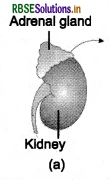
Question 9.
Mention at least two glands that are not part of endocrine system but produce hormones.
Answer:
Heart, Kidney.
Question 10.
Classify the types of hormones.
Answer:
- Protein hormone
- Steroid hormone
- Iodothyronine hormone
- Amino acid derivative hormone.
Short Answer Type Questions
Question 1.
Draw a labelled diagram of location of endocrine glands in human body.
Answer:

Question 2.
Write in short about hypothalamus in our body.
Answer:
The human body has different types of glands:
- Exocrine glands
- Endocrine glands and
- Mixed type glands
The secretion of endocrine glands are called hormones. Scientific definition of hormone is:
Hormones are non - nutrient chemicals which acts as intercellular messangers and are produced in trace amounts. The new definition covers a number of new molecules in addition to the hormones secreted by the organised endocrine glands such as: Steroids, proteins and protein derivatives. Invertebrates have very simple endocrine system. Whereas in vertebrates there are many chemicals that acts as hormones and provides coordination.
Question 3.
Classify the different hormone, produced by different parts of pituitary gland.
Answer:
The body cavity called sella turcica ladges the pituitary gland. It is attached to hypothalamus by a stalk. The division of hormones produced by pituitary gland are:
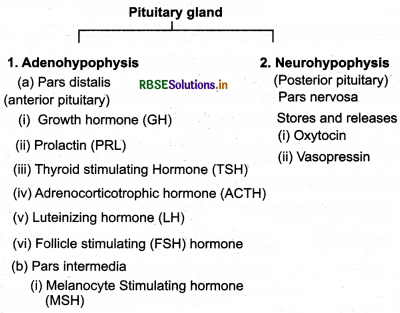
The excess (hyper) secretion of hormones and less (hypo) secretion of hormones causes hormonal imbalance in the body and causes many disorders. This can be contracted by certain medicines.
1. Growth Hormone (GH): Excess secretion (hyper) of GH in adults and specially in middle age causes serious complications. The face is disfigured and this condition is known as acromegaly. It may also leads to death if it goes unchecked. It often goes undetected for many years, till external features are visible.
The less secretion of GH results in abnormal growth - stunted growth is called pituitary dwarfism. Thus, Gigantism (giant like body) and dwarf (small body) are two abnormalities due to GR secretion. To have a normal body growth GR should be produced in correct amount. Kyphosis is due to bending of back bone (vertibral column).
2. Prolactin (PRL/PL): This hormone is responsible for growth of mammary glands and formation of milk in adult females.
3. Thyroid Stimulating Hormone (TSH): This hormone stimulates the synthesis and secretion of thyroid hormones from thyroid gland located in neck region. Less secretion of thyroid stimulating hormone causes goitre .
4. Adrenocorticotrophic hormone (ACTH): ACTH stimulates the secretion of steroid hormones known as glucocorticoids from the adrenal cortex that is located on top of kidneys like a cap/crown.
5. Lutetnizing hormone (LH) and Follicle Stimulating hormone (FSH): These hormones stimulate the gonads and hence, are also called gonadotrophins. LH in males stimulates the synthesis and secretion of hormones called androgens from testis (gonads). Where as FSH and androgens are responsible for regulating the sperm atogenesis (i. e., formation of sperms). In females LH induces the ovulation process (release of egg/ovum) the fully mature graafian follicles and maintains the corpus luteum (yellow spot) that secretes hormones. FSH stimulates growth and development of the ovarian follicles.
6. Metanocyte StimuLating hormone (MSH): The pigmentation of the skin (colour) is due to melanin contain cells called melanocytes. It is regulated by MSH.
7. Oxytocin: This hormone acts on the smooth muscles (involuntary muscles) of our body and stimulates their contraction. In females the stimulation for vigrous contraction of uterus during the time of child birth. It also helps in ejection of milk after child birth from mammary glands.
8. Vasopressin: It is also called anti - diuretic hormone (ADH). It controls the reabsorption of water and electrolytes from the distal tubules (DT) or nephrons in kidney. It is called diuresis. It reduces the loss of water. When the ADH is less secreted it.leads to the excess loss of water and dehydration occurs. The kidney is unable to conserve water. This disorder is called diabetes insipidus.

Question 4.
Write about the role of vasopressin.
Answer:
Vasopressin: It is also called anti - diuretic hormone (ADH). It controls the reabsorption of water and electrolytes from the distal tubules (DT) or nephrons in kidney. It is called diuresis. It reduces the loss of water. When the ADH is less secreted it.leads to the excess loss of water and dehydration occurs. The kidney is unable to conserve water. This disorder is called diabetes insipidus.
Question 5.
Differentiate between hyper and hypo thyroidism.
Answer:
Hyperthyroidism is an overactive thyroid (when it produces too much thyroid hormone). Hypothyroidism is an underactive thyroid (when it does not produce enough). Hypothyroidism is more common than hyperthyroidism. Although the two conditions have different signs and symptoms, sometimes they overlap.
Question 6.
Write the functions of thyroid hormones.
Answer:
Thyroid hormone (T3 and T4) affects every cell and all the organs in your body by:
Regulating the rate at which your body uses calories (energy). This affects weight loss or weight gain and is called the metabolic rate.
Slowing down or speeding up your heart rate.
Question 7.
Mention the function of mineral corticoids.
Answer:
- Aldosterone is the main mineral corticoid that acts on renal tubules of kidneys and stimulates the reabsorption of Na+ and water and excretion of K+ and phosphate (PO4)- ions.
- Helps in maintenance of electrolytes, blood fluid volume, osmotic pressure and blood pressure.
- Secretion of small amounts of androgenic steroids are also, secreted by adrenal cortex. They help in growth of axial hair, pubic hair and facial hair during puberty.
Question 8.
Write in short about: α, ß, δ cells.
Answer:
1. α (alpha) cells: They form about 25% in number and average sized cells. These cells produce a hormone called glucagon. They converts the stored glycogen → glucose (i.e., glycolysis) and formation of glucose from fats and amino acids (it is called gluconeogenesis).
2. ß (beta) cells: These cells are larger in number and bigger in size responsible for secretion of insulin hormone. It change/regulates the level of glucose in blood and converts excess of it into glycogen in liver and muscles.
3. δ (delta) cells: These cells are smaller in size and less in number. These cells secrete somatostatin hormone. It obstructs the working of glucogon and insulin thereby, assimilation of digested food into body is delayed.
Question 9.
What are the functions of glucagon?
Answer:
- It is a peptide hormone and places an important role in maintaining normal levels of glucose in blood.
- It mainly acts on hepatocytes (liver cells) and stimulates gluconeogenesis resulting in an increased blood sugar (hyperglycemia).
- It reduces the cellular glucose intake and utilization thereby, hyperglycemia. This hormone is also called hyperglycemic hormone.

Question 10.
Mention three organs that are endocrine in nature but not part of endocrine system.
Answer:
1. Heart: The atrial wall of heart secretes a very important peptide hormone called atrial natriuretic factor - ANF. It decreases blood pressure. When the BP is increased ANF is secreted and it causes dilation of the blood vessels and then reduces the blood pressure.
2. Kidney: The juxtaglomerular cells of the kidney produce peptide hormone called (i) erythropoietine. This hormone stimulates the formation of RBCs (erythropoiesis). (ii) Renin for ultra filtration, (iii) Renomedullary postaglandins - increase Na+ content in urine.
3. GI tract: The endocrine cells present in gastrointestinal tract (GI) and are responsible to produce four major peptide hormones. These are (i) gastrin, (ii) secretin, (iii) cholecystokinin (cck) and (iv) gastric inhibitory peptide (GIP). GIP inhibites gastric secretion and motility.
Long Answer Type Questions
Question 1.
Draw the diagram showing the relationship between hypothalamus and pituitary. Mention the hormones produced by the labelled parts.
Answer:
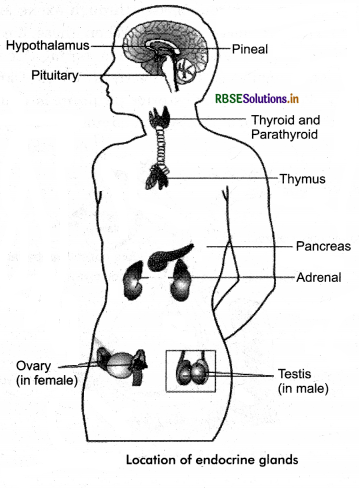
The endocrine system has different endocrine glands situated at different location in our body.
These are: pituitary, pineal, thyroid, adrenal, pancreas, parathyroid, thymus, gonads: in males testis, in female ovary, are the organised endocrine bodies in our body. Also, the following produce hormones e.g., gastrointestinal tract, liver, kidney and heart. Let us study about these structures/organs.
Hypothalamus:
Hypothalamus is the basal part of the diencephalon, forebrain and it regulate a wide spectrum (range) of body functions. It has several groups of neurosecretory cells called nuclei which produce hormones. These hormones regulate the synthesis and secretion of pituitary hormones. Two types of hormones produced are:
1. Stimulating or release hormones that when released they stimulate the pituitary to release their secretions/ hormones. They are denoted as RA. e.g., Gonadotrophin releasing hormone: GnRH. This hormone stimulates the secretion of gonadotrophins synthesis and their release.
2. Inhibitory hormones that when released they check/ stop/inhibit the secretion of hormones, e.g., somatostatin hormones is a inhibiting hormone released by hypothalamus. It inhibits the release of growth hormone (GH) from the pituitary gland. These hormones originate the hypothalamic neurons passes through axons and are released at their nerve endings. When these hormones reach the pituitary gland through a portal circulatory system and regulates the functions of the anterior pituitary. Where as, the posterior pituitary is under the direct neural control of the hypothalamus.
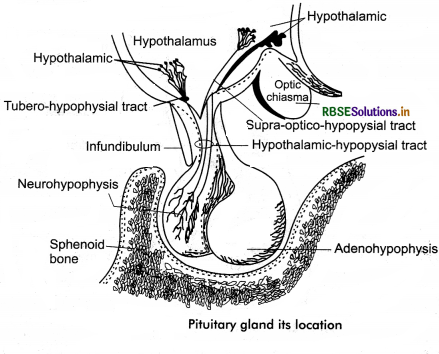
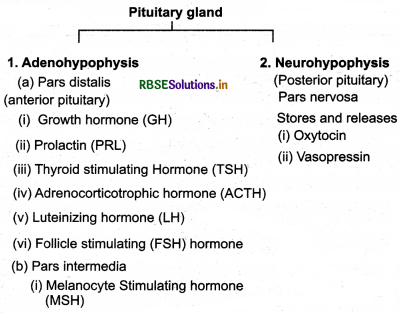
The excess (hyper) secretion of hormones and less (hypo) secretion of hormones causes hormonal imbalance in the body and causes many disorders. This can be contracted by certain medicines.
1. Growth Hormone (GH): Excess secretion (hyper) of GH in adults and specially in middle age causes serious complications. The face is disfigured and this condition is known as acromegaly. It may also leads to death if it goes unchecked. It often goes undetected for many years, till external features are visible.
The less secretion of GH results in abnormal growth - stunted growth is called pituitary dwarfism. Thus, Gigantism (giant like body) and dwarf (small body) are two abnormalities due to GR secretion. To have a normal body growth GR should be produced in correct amount. Kyphosis is due to bending of back bone (vertibral column).
2. Prolactin (PRL/PL) : This hormone is responsible for growth of mammary glands and formation of milk in adult females.
3. Thyroid Stimulating Hormone (TSH): This hormone stimulates the synthesis and secretion of thyroid hormones from thyroid gland located in neck region. Less secretion of thyroid stimulating hormone causes goitre .
4. Adrenocorticotrophic hormone (ACTH): ACTH stimulates the secretion of steroid hormones known as glucocorticoids from the adrenal cortex that is located on top of kidneys like a cap/crown.
5. Lutetnizing hormone (LH) and Follicle Stimulating hormone (FSH): These hormones stimulate the gonads and hence, are also called gonadotrophins. LH in males stimulates the synthesis and secretion of hormones called androgens from testis (gonads). Where as FSH and androgens are responsible for regulating the sperm atogenesis (i. e., formation of sperms). In females LH induces the ovulation process (release of egg/ovum) the fully mature graafian follicles and maintains the corpus luteum (yellow spot) that secretes hormones. FSH stimulates growth and development of the ovarian follicles.
6. Metanocyte StimuLating hormone (MSH): The pigmentation of the skin (colour) is due to melanin contain cells called melanocytes. It is regulated by MSH.
7. Oxytocin: This hormone acts on the smooth muscles (involuntary muscles) of our body and stimulates their contraction. In females the stimulation for vigrous contraction of uterus during the time of child birth. It also helps in ejection of milk after child birth from mammary glands.
8. Vasopressin: It is also called anti - diuretic hormone (ADH). It controls the reabsorption of water and electrolytes from the distal tubules (DT) or nephrons in kidney. It is called diuresis. It reduces the loss of water. When the ADH is less secreted it.leads to the excess loss of water and dehydration occurs. The kidney is unable to conserve water. This disorder is called diabetes insipidus.
Question 2.
Write in short about:
(i) GH
(ii) Oxytocin
(iii) PTH
(iv) Thymosin
(v) Emergency hormone.
Answer:
(i) Growth Hormone (GH): Excess secretion (hyper) of GH in adults and specially in middle age causes serious complications. The face is disfigured and this condition is known as acromegaly. It may also leads to death if it goes unchecked. It often goes undetected for many years, till external features are visible.
The less secretion of GH results in abnormal growth - stunted growth is called pituitary dwarfism. Thus, Gigantism (giant like body) and dwarf (small body) are two abnormalities due to GR secretion. To have a normal body growth GR should be produced in correct amount. Kyphosis is due to bending of back bone (vertibral column).
(ii) Oxytocin: This hormone acts on the smooth muscles (involuntary muscles) of our body and stimulates their contraction. In females the stimulation for vigrous contraction of uterus during the time of child birth. It also helps in ejection of milk after child birth from mammary glands.
(iii) Function of PTH:
- To regulate the levels of Ca++ in blood (increase).
- Along with thyrocalcitonin (TCT) it balances the Ca++ level in body.
- Stimulates the reabsorption of Ca2+ by the renal tubules and increased absorption of Ca2+ from the digested food.
(iv) Functions of Thymosin:
- Differentiation of T - lympocytes, which provides cell mediated immunity.
- Production of antibodies for providing humoral immunity.
(v) The Emergency hormone is the name given to the adrenaline hormone.
Explanation:
The adrenal medulla secretes adrenaline hormone at times of stress or emergency, and it is hence known as the emergency hormone. Adrenaline is released into the bloodstream during an emergency.

Question 3.
Write the functions of catecholamines.
Answer:
There is a pair of adrenal glands located on the top of kidneys like a crown/cap. One kidney has one adrenal gland. A section of the gland show that it has 2 parts.
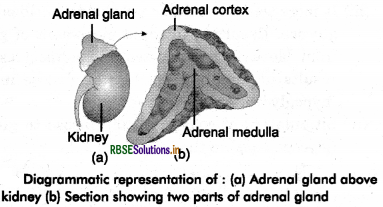
L Adrenal Cortex: The outer portion of the adrenal gland is called adrenal cortex. It can be divided into three layers:
- Zona glomerulosa: the outermost layer.
- Zona fasciculata: the middle layer.
- Zona recticularis: the inner most layer.
The cortex secrets many hormones which are collectively called corticoids.
(a) The corticoids involved in the carbohydrate metabolsim are called glucocorticoids. The main one in called cortisol.
(b) The corticoids responsible/regulate the electrolytes and water balance in the body are called mineralocorticoids. The main one is aldosterone.
Functions of glucocorticoids:
1. They stimulate - gluconeogenesis, lipolysis and proteolysis and inhibit the cellular uptake and utilization of amino acids.
2. Cortisol the main glucocorticoid is involved in maintaining cardiovascular system, kidney functions, anti - inflammatory reactions, supression of the immune response, stimulation of RBC production (erythropoiesis). Under production/ secretion/hyper condition of the adrenal cortex changes the carbohydrate metabolism resulting in acute weakness and fatigue. This disease/ condition is called Addison’s disease.
Functions of Mineralocorticolds:
1. Aldosterone is the main mineral corticoid that acts on renal tubules of kidneys and stimulates the reabsorption of Na and water and excretion of K and phosphate (PO4 )- ions.
2. Helps in maintenance of electrolytes, blood fluid volume, osmotic pressure and blood pressure. Secretion of small amounts of androgenic steroids are also, secreted by adrenal cortex. They help in growth of axial hair, pubic hair and facial hair during puberty.
2. Adrenal Medulla: It is the centrally located portion of the gland that produces two hormones:
- Adrenaline/epinephrine.
- Noradrenaline/nor epinephrine.
Collectively these hormones are called catecholamines. These hormones are rapidly secreted in response to emergency situation and hence also termed as emergency hormones or hormones of fight or flight. i.e., in such situations either you fight / face the situation and overcome it or ffight/escape from it.
Functions of Catecholamiries:
- Increase alterness, pupil dilation, piloerection (raising of hair) and sweating etc.
- Increase in heart beats, strength of heart contraction (for pumping move blood) and rate of respiration.
- Stimulation of breakdown of glycogen: glycolysis, hyperglycemia: high concentration of glucose in blood (for more production of energy), Lipolysis (break - down of lipids), protolysis (break down of proteins).
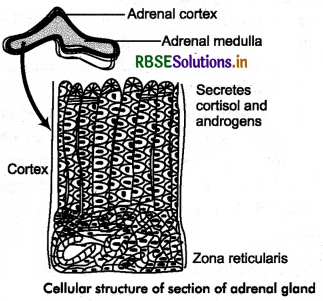
Disorder and Diseases due to
Hypersecretton of Adrenal Glands:
- Addison’s disease
- Hypoglycemia
- Conn’s disease.
Hyposecretion of Adrenal Gland:
- Cushing’s syndrome
- Aldosteronism
- Adrenal Virilism: Female develops male like characters, sterlity in females, sexual imaturity in male.
Question 4.
Draw the figure of cellular structure of pancreatic gland. Discuss in short about the hormones released by it.
Answer:

The pancreas is a composite and mixed gland behaves like an endocrine and exocrine gland. The endocrine part of pancreas is represented/consists of Islets of Langerhans. There are about 1 - 2 million islets of Langerhans in the pancreas. It has:
1. α (alpha) cells: They form about 25% in number and average sized cells. These cells produce a hormone called glucagon. They converts the stored glycogen → glucose (i.e., glycolysis) and formation of glucose from fats and amino acids (it is called gluconeogenesis).
2. ß (beta) cells: These cells are larger in number and bigger in size responsible for secretion of insulin hormone. It change/regulates the level of glucose in blood and converts excess of it into glycogen in liver and muscles.
3. δ (delta) cells: These cells are smaller in size and less in number. These cells secrete somatostatin hormone. It obstructs the working of glucogon and insulin thereby, assimilation of digested food into body is delayed.
Functions of Glucagon:
- It is a peptide hormone and places an important role in maintaining normal levels of glucose in blood.
- It mainly acts on hepatocytes (liver cells) and stimulates gluconeogenesis resulting in an increased blood sugar (hyperglycemia).
- It reduces the cellular glucose intake and utilization thereby, hyperglycemia. This hormone is also called hyperglycemic hormone.
Functions of Insulin:
- It is a peptide hormone and plays a major role in regulation of glucose homeostasis.
- It mainly acts on hepatocytes (liver cells) and adipocytes (fats cells).
- It increases the cellular uptake and utilization of glucose. Resulting in rapid movement of glucose from blood to hepatocytes and adipocytes. This results in turn in low levels of glucose in blood (hypoglycemia).
- Sitmulation of conversion of glucose to glycogen (glycogenesis) in the target cells.
Diabetes mellitus is the prolonged hyperglycemia condition or complex disorder. Symptoms are : loss of glucose through urine and formation of harmful compounds called ketone bodies. Diabetes mellitus is also called sweet diabetes. Controlled sugar intake, exercise corrects it. Also insulin therapy is done for diabetic patients.

Question 5.
Discuss about the mechanism of action of hormones. Support your answer with appropriate diagrams.
Answer:
The mechanism of hormone action on the target organ/ tissue/cell can be understood as follows:
Hormone receptors: Hormone receptors are specific proteins which are present on the cell membrane or inside the cell.
- Hormone receptors on the cell membrane are called membrane bound receptors.
- Hormone receptors present inside the cell are called intracellular hormone receptor and are mostly present in the nucleus hence called nuclear receptors.
The union of hormone and receptor forms a complex called hormone - receptor complex. Each hormone binds to a specific receptor. i.e., this is hormone/receptor specific. This complex formation leads to certain biochemical change in the target tissue. The target tissue’s metabolism and physiological function are thus, regulated by hormones. Those hormones which are bound to the membrane receptors normally do not enter the target cell, but instead generate a second messengers e.g., cyclic AMP, IP3, Ca++ etc. Which in turn regulate the metabolism of the cell.
The hormones that enter the cell and interact with the intracellular receptors e.g., steroid hormones, iodothyronines etc. These results in mostly regulation of gene expression/chromosome function by the interaction of hormone receptor complex with the genome. Cumulative biochemical action results in the physiological and developmental effects in the individual.

